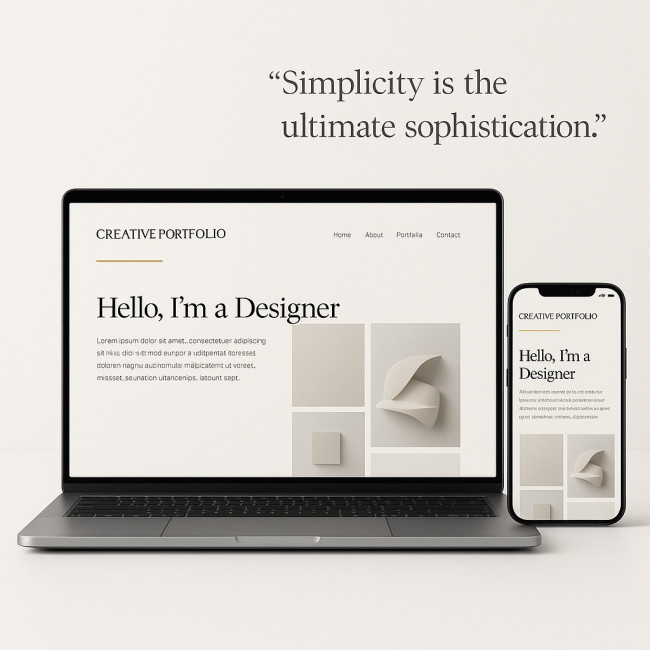Integrate client testimonials seamlessly without overcrowding your showcase
Client testimonials can double conversion rates, yet cramming too many quotes will slow your page, dilute your visuals and distract recruiters. This guide shows you how to weave social proof into any creative portfolio so that each endorsement shines without stealing the spotlight from your work.
Why client testimonials still sway decision-makers in 2024
Eye-tracking studies from Nielsen Norman Group show that visitors scan social proof elements before reading long descriptions. In the creative industries, where trust is paramount, authentic client testimonials reduce perceived hiring risk and speed up shortlist decisions.
- Authority boost – Logos or named brands lend third-party validation.
- Project context – A concise quote clarifies the result you delivered.
- Emotion trigger – Positive adjectives from real clients spark excitement and memorability.
The overcrowding dilemma
Piling every rave review onto one page can backfire. Common symptoms include:
- Slow load times that raise bounce rate.
- Visual noise that hides your actual work.
- Cognitive fatigue—visitors stop reading after the third quote.
The goal is balance: you want enough proof to reassure, not so much that it overwhelms.
Seven strategic placements that feel natural

From hero headers to email signatures, each placement serves a different psychological checkpoint along the visitor journey. Think of them like rhythmic beats in a song: visible just long enough to reinforce credibility before the next verse—your actual work—takes center stage. When you distribute testimonials across these seven zones, you minimise cognitive load, maintain visual hierarchy and still land dozens of subtle trust cues. The result is a showcase that feels airy yet convincing, never desperate.
1. Hero header micro-quote
Insert a single, punchy sentence—10 words max—below your hero image. It captures attention without pushing the main call-to-action down the fold.
2. Carousel under portfolio grid
Create a three-slide slider that auto-advances every six seconds. Each slide features one testimonial, the client's name and a tiny project thumbnail. Limit the set to three to avoid “quote fatigue.”
3. Inline quote next to case study results
While narrating a project, break up the text with a <blockquote></blockquote> element. The testimonial should relate directly to the metric you just mentioned, reinforcing credibility.
4. Sidebar “Trust Column” on blog posts
Dedicated sidebars keep testimonials visible without intruding on the main narrative. Rotate two quotes every week so returning visitors see fresh proof.
5. Footer ticker
A slim ticker displaying client names and a three-word verdict (“On time, wow!”) provides reinforcement site-wide with minimal vertical space.
6. Lead magnet confirmation page
After someone downloads your rate card, add two testimonials confirming ROI. They validate the upsell without bloating the main showcase.
7. Email signature snippet
Add a single-line testimonial below your contact details. It does not crowd your website but still reinforces expertise in every follow-up thread.
Design tips to let social proof breathe
| Element | Best practice | Common pitfall |
|---|---|---|
| Typography | Use one size smaller than body text to keep hierarchy clear. | Italicising long paragraphs—harder to read on mobile. |
| Colour | Neutral tones (#555555) for body, accent (#95854c) for author name. | High-saturation backgrounds that clash with artwork. |
| Length | 45-60 words for standard quotes. | Posting full emails—visitors skim and forget. |
| Image | Optional 40 px circular avatar. | Low-res photos that break visual polish. |
Automation & maintenance workflows

Manual copy-paste routines quickly break when your portfolio scales past a handful of projects, so treating testimonials as a living dataset is crucial. By layering lightweight forms, tagging systems and periodic audits, you build an automated conveyor belt that keeps the freshest, most relevant quotes in circulation. Visitors always see proof that matches the content they're viewing, while you avoid the dreaded “stale praise” effect that erodes credibility over time.
- Collect continuously. Use a short Typeform at project wrap-up. Ask for a score and a 1-sentence win.
- Tag by topic. Assign labels like “timeline,” “communication” or “ROI” so you can surface the right quote near matching content.
- Rotate quarterly. Archive older testimonials in a Notion database and replace the lowest-performing ones based on scroll-depth analytics.
- Show the source. Link to richer success stories on platforms such as Artfolio's new-portfolio spotlight to add depth without replicating long texts.
Example flow: from request to placement
Imagine you've just delivered a branding shoot. During final file delivery you send a form requesting feedback. The client replies:
“The visuals doubled our click-through rate within a week—flawless collaboration.”
— Maya Torres, Creative Director
You add this quote to:
- The branded-content case study (inline blockquote).
- Your email signature.
- The footer ticker.
Because it mentions a metric, you tag it “ROI” for future rotations.
Internal resources for deeper trust tactics
Need to level up your social proof even further? Explore these guides:
- Peer endorsement strategies – learn how to gather credible quotes fast.
- Spotlighting testimonials in talent directories – placement ideas transferable to any portfolio.
- Turning live reviews into portfolio gold – convert real-time praise into evergreen assets.
Quick self-assessment quiz
FAQ
- How many testimonials should appear on my homepage?
- Three is a proven sweet spot: one micro-quote in the hero, one blockquote mid-page and one in the footer ticker.
- Can I edit a client's wording for clarity?
- Yes, but request approval before publishing. Minor edits for grammar or length are acceptable if they preserve intent.
- Should I include star ratings?
- Star icons work well on service-oriented pages, but on a visual portfolio they can clash with your design. Use them sparingly, such as in a sidebar widget.
Wrap-up & next step
When integrated thoughtfully, client testimonials act as subtle but powerful proof points that move your visitors from curious to convinced. Start by placing three well-chosen quotes, measure the impact, then iterate.
Ready to upgrade your social proof? Download the free “Testimonial Placement Checklist” and watch your portfolio's conversion rate climb.











